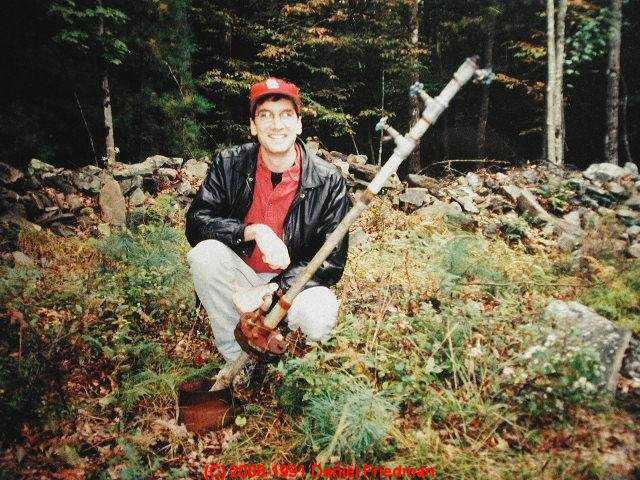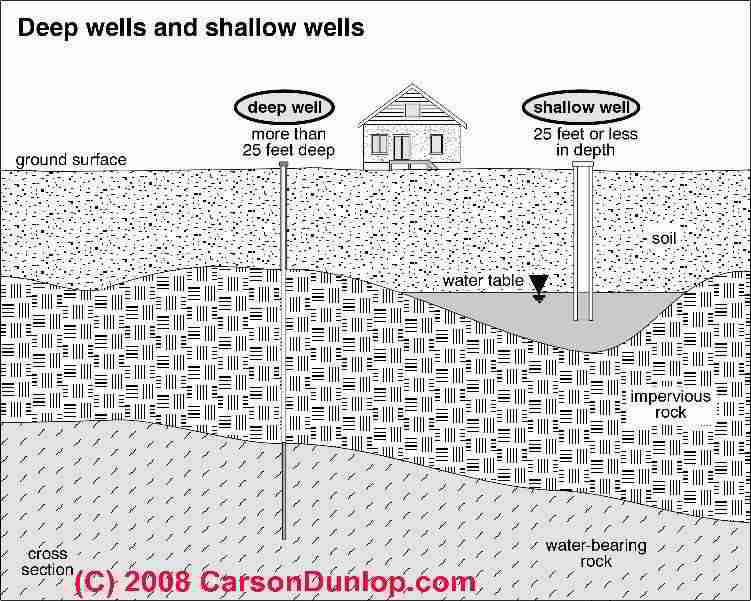 Flooded Well Pollution
Flooded Well Pollution
How to Protect Groundwater from Surface Pollutants &
How to Restore a well to service after area flooding
- POST a QUESTION or COMMENT about how to correct contaminated or polluted (unsanitary) well water
How to protect a drinking water well from common sources of ground water / well water contaminants.
Page top photo: because this steel well casing top was close to ground level and so loose that our inspection client could simply the whole well piping apparatus out of the ground we warned that there was also a risk of well water contamination.
InspectAPedia tolerates no conflicts of interest. We have no relationship with advertisers, products, or services discussed at this website.
- Daniel Friedman, Publisher/Editor/Author - See WHO ARE WE?
Flooded Well Contamination
 Our edited, re-ordered and expanded version of original EPA text given here describes types of activities in your area that can create threats to your water supply.
Our edited, re-ordered and expanded version of original EPA text given here describes types of activities in your area that can create threats to your water supply.
It also describes problems to look for and offers maintenance suggestions. Sources for more information and help are also listed.
[Click to enlarge any image]
Editing for clarity by DF are marked by brackets or italics] Initial Source: EPA 816-K-02-003 January 2002. Quoting the EPA: If your family gets drinking water from your own well, do you know if your water is safe to drink?
What health risks could you and your family face? Where can you go for help or advice? This pamphlet helps answer these questions.
The sketch at left showing how deep or shallow wells tap aquifers is provided courtesy of Carson Dunlop Associates, a Toronto home inspection, education & report writing tool company [ carsondunlop.com ].
Flooded Well Action Priorities
Watch out: don't drink from flooded wells: in areas of widespread flooding such as the Houston Texas area flooding during hurricane Harvey in 2017, water from both public and private water wells that were submerged by or even close to areas covered by floodwaters is not safe to drink.
During flooding both surface water and groundwater become contaminated with a wide range of pollutants including sewage, an immediate health hazard, and other contaminants such as lead, pesticides, fertilizers, and depending on the well location, petroleum products such as carcinogenic benzene.
If you need drinking water right now, see DRINKING WATER EMERGENCY SOURCES - where to find emergency drinking water after a flood or other disaster.
In an emergency, disinfecting water by boiling or other disinfection methods
Watch out: simply shocking your well (WELL CHLORINATION SHOCKING PROCEDURE) is not enough to give safe drinking water after area flooding, even if you include disinfection of the well and building piping, water tank, and water heater tank.
That's because it's likely that the groundwater that enters your well has been contaminated by the recent floodwaters.
You will need to confirm that the well water is safe to drink at two points:
- When local authorities say that community wells and water delivery systems have been sanitized
and that the community water is safe to drink.
You may still need to sanitize the water piping in your building and you will need to drain and sanitize any water holding tanks like the water pressure tank and water heater tank. - When your own local or private well has been sanitized
and then after waiting no less than 24 hours, (safer is to wait 2-4 days) the water supply has been re-tested to confirm that polluted water is not enteriong your well.
The bare minimum water potability test to be performed is a bacteria test or coliform test. That will identify the most-common well contaminant from sewage or from flooded septic systems. That test will also tell us if surface water or sewage-contaminated groundwater is entering the water well.
Watch out: bacteria testing will not guarantee that other contaminants such as benzene, pesticides, fertilizers, lead, or other pollutants are out of your water supply. Your local water testing department and local health officials will have additional advice on what other contaminants should be included in private well-water testing.
See BACTERIA TEST GUIDE and see WATER QUALITY TEST CHOICES & WATER TEST FEES
Also see COLIFORM STANDARDS for DRINKING WATER - what are the allowable levels of total coliform and e-coli in drinking water?
After A Flood - Well Water Contamination Safety Warnings & Health Advisories from the U.S. EPA
- Watch out: Avoid fatal electrical shock hazards:
stay away from the well pump, electrical controls, wiring, etc. while the building is flooded or is still wet, in order to avoid electric shock.
Do not try to turn on the pump nor other well or water treatmenbt equipment before the electrical components have been dried and inspected. Keep in mind that flood-bourned mud and debris may have both contaminated the water well and may have clogged or damaged the pump - so just turning on the pump risks damagign it.
See ELECTRICAL SAFETY for FLOOD INSPECTORS for details. - Do not drink or wash using water from a flooded well to avoid becoming sick. See
- Turn on the well pump & controls once they are safe,
dry, restored. Get assistance from a well or pump contractor to clean and turn on the pump.
In addition to the need to restore the water pump, wiring, and pressure controls to safe operation, if the well was open to groundwaters it may have become loaded with mud and silt, even sewage-contaminants. If that happened the well will need to be cleaned before it can be restored to use. - Flush out the flooded well:
After the pump is turned back on, run water from the well until the well water runs clear to rid the well of flood water.
If the well casing remained sealed during flooding, restoring the well to service will still involve shocking the well and water piping system and may require water testing for contaminants. - Watch out: : If the well water does not run clear,
get advice from the county or state health department or extension service or from your local well driller and water treatment company.
Watch out: in some cases, just clearing the well casing and piping themselves of floodwaters may not be enough. In periods immediately after area flooding local groundwaters and some aquifers may themselves be contaminated.
If authorities in your area confirm that this is the case, you may need to test the well water to see if it is safe to use, or a water treatment system (such as a chlorinator) may be needed. See- WELL CHLORINATION & SHOCKING to see how to sanitize your well and building water piping
- WATER TESTING ADVICE
- WATER TREATMENT EQUIPMENT CHOICES - home
- WELL REPAIR AFTER A FLOOD -
For additional information about restoring a water well to operation after a flood see- WELL CLEANING PROCEDURES
- WELL CLEANING & RESTORATION by GLYCOLIC ACID
- WELL DISINFECTION PROCEDURE, POST FLOODING
- WELL DISINFECTANT TABLE, POST FLOODING
- PRIVATE WELLS: GUIDANCE FOR WHAT TO DO AFTER THE FLOOD - PDF copy of advice from the U.S. EPA
- FLOOD DAMAGE CLEANUP & REPAIR GUIDE - home
- Additional flood damage restoration articles pertiaining to wells, pumps, piping are atReferences or Citations below
When Building, Modifying Or Closing A Well
- Hire a certified well driller for any new well construction or modification
- Slope well area so surface runoff drains away
- When closing a well:
- Do not cut off the well casing below the land surface
- Hire a certified well contractor to fill or seal the well
Preventing [Well Water Contamination] Problems
- Install a locking well cap or sanitary seal to prevent unauthorized use of, or entry into, the well
- Do not mix or use pesticides, fertilizers, herbicides, degreasers, fuels, and other pollutants near the well
- Never dispose of wastes in dry wells or in abandoned wells
- Pump and inspect septic systems as often as recommended by your local health department
- Never dispose of hazardous materials in a septic system
- Take care in working or mowing around your well
Maintaining Your Well
- Each month check visible parts of your system for problems such as:
- Cracking or corrosion,
- Broken or missing well cap,
- Settling and cracking of surface seals
- Have the well tested once a year for coliform bacteria, nitrates, and other contaminants
- Keep accurate records in a safe place, including:
- Construction contract or report
- Maintenance records, such as disinfection or sediment removal
- Any use of chemicals in the well
- Water testing results
...
Continue reading at 1. How To FIND WELL CONTAMINATION PROBLEMS or select a topic from the closely-related articles below, or see the complete ARTICLE INDEX.
Or see these
Recommended Articles
Suggested citation for this web page
FLOOD CONTAMINATED WELL RESTORE & PROTECT at InspectApedia.com - online encyclopedia of building & environmental inspection, testing, diagnosis, repair, & problem prevention advice.
Or see this
INDEX to RELATED ARTICLES: ARTICLE INDEX to WATER SUPPLY, PUMPS TANKS WELLS & SPRINGS
Or use the SEARCH BOX found below to Ask a Question or Search InspectApedia
Ask a Question or Search InspectApedia
Questions & answers or comments about how to protect a well from becoming polluted & how to restore a water well to service after area flooding.
Try the search box just below, or if you prefer, post a question or comment in the Comments box below and we will respond promptly.
Search the InspectApedia website
Note: appearance of your Comment below may be delayed: if your comment contains an image, photograph, web link, or text that looks to the software as if it might be a web link, your posting will appear after it has been approved by a moderator. Apologies for the delay.
Only one image can be added per comment but you can post as many comments, and therefore images, as you like.
You will not receive a notification when a response to your question has been posted.
Please bookmark this page to make it easy for you to check back for our response.
IF above you see "Comment Form is loading comments..." then COMMENT BOX - countable.ca / bawkbox.com IS NOT WORKING.
In any case you are welcome to send an email directly to us at InspectApedia.com at editor@inspectApedia.com
We'll reply to you directly. Please help us help you by noting, in your email, the URL of the InspectApedia page where you wanted to comment.
Citations & References
In addition to any citations in the article above, a full list is available on request.
- [1] Drinking Water from Household Wells - PDF, U.S. EPA, Original source last retrieved 2/13/2013, original source: http://www.epa.gov/privatewells/pdfs/household_wells.pdf
- [1] Private Wells: Guidance for What to Do After the Flood - PDF copy, U.S. EPA, retrieved 2/12/2013, original sourcehttp://water.epa.gov/drink/info/well/whatdo.cfm
- In addition to citations & references found in this article, see the research citations given at the end of the related articles found at our suggested
CONTINUE READING or RECOMMENDED ARTICLES.
- Carson, Dunlop & Associates Ltd., 120 Carlton Street Suite 407, Toronto ON M5A 4K2. Tel: (416) 964-9415 1-800-268-7070 Email: info@carsondunlop.com. Alan Carson is a past president of ASHI, the American Society of Home Inspectors.
Thanks to Alan Carson and Bob Dunlop, for permission for InspectAPedia to use text excerpts from The HOME REFERENCE BOOK - the Encyclopedia of Homes and to use illustrations from The ILLUSTRATED HOME .
Carson Dunlop Associates provides extensive home inspection education and report writing material. In gratitude we provide links to tsome Carson Dunlop Associates products and services.

